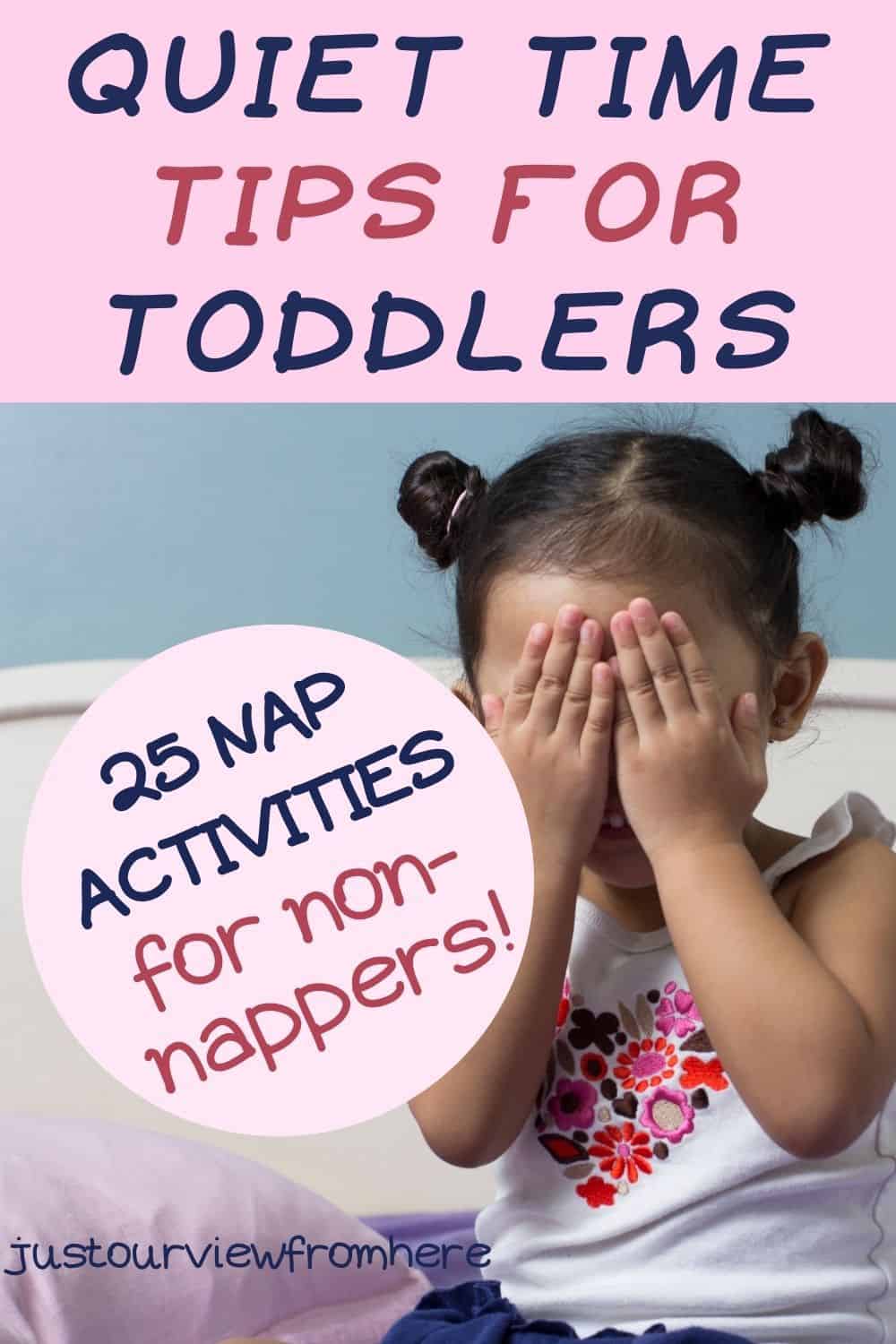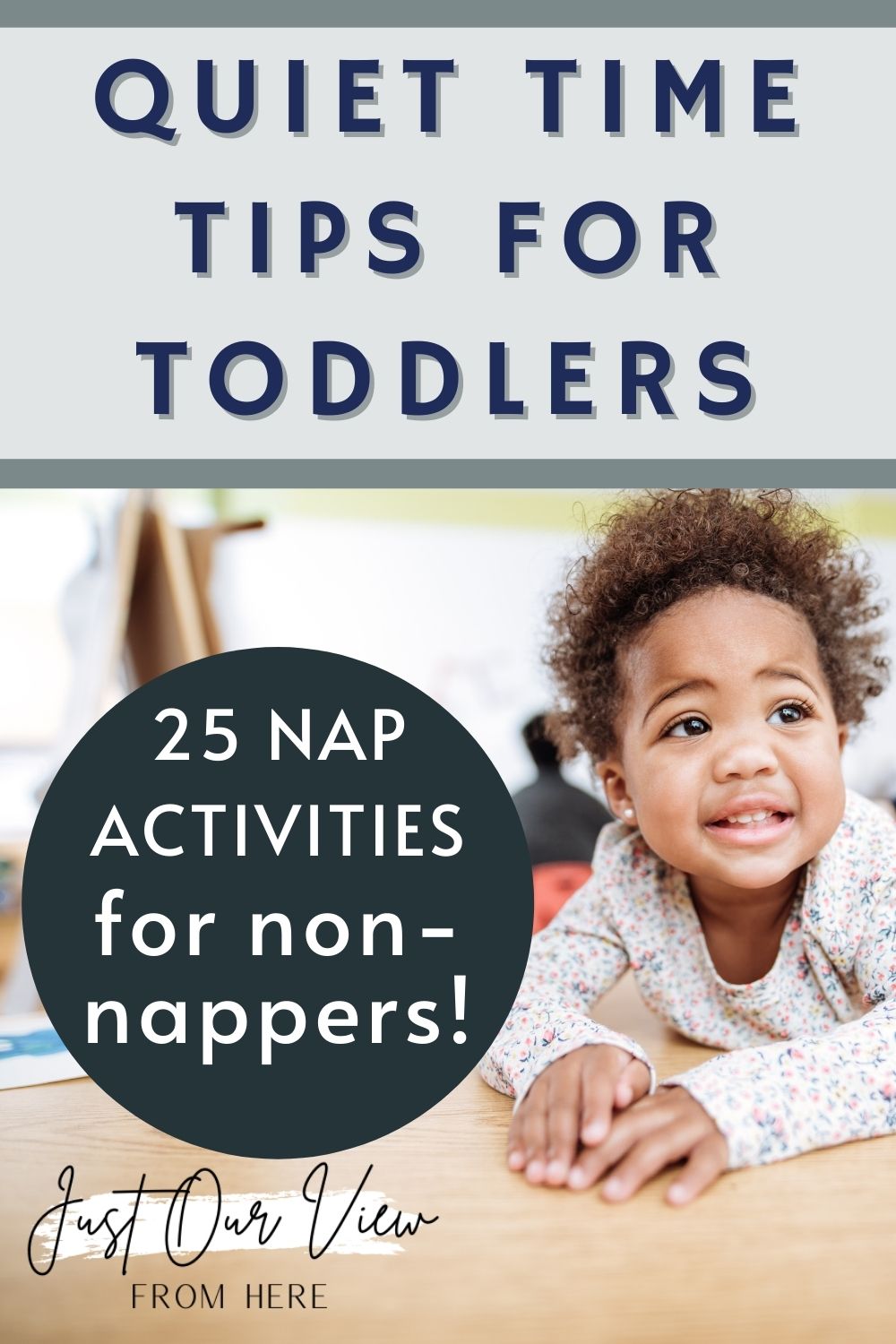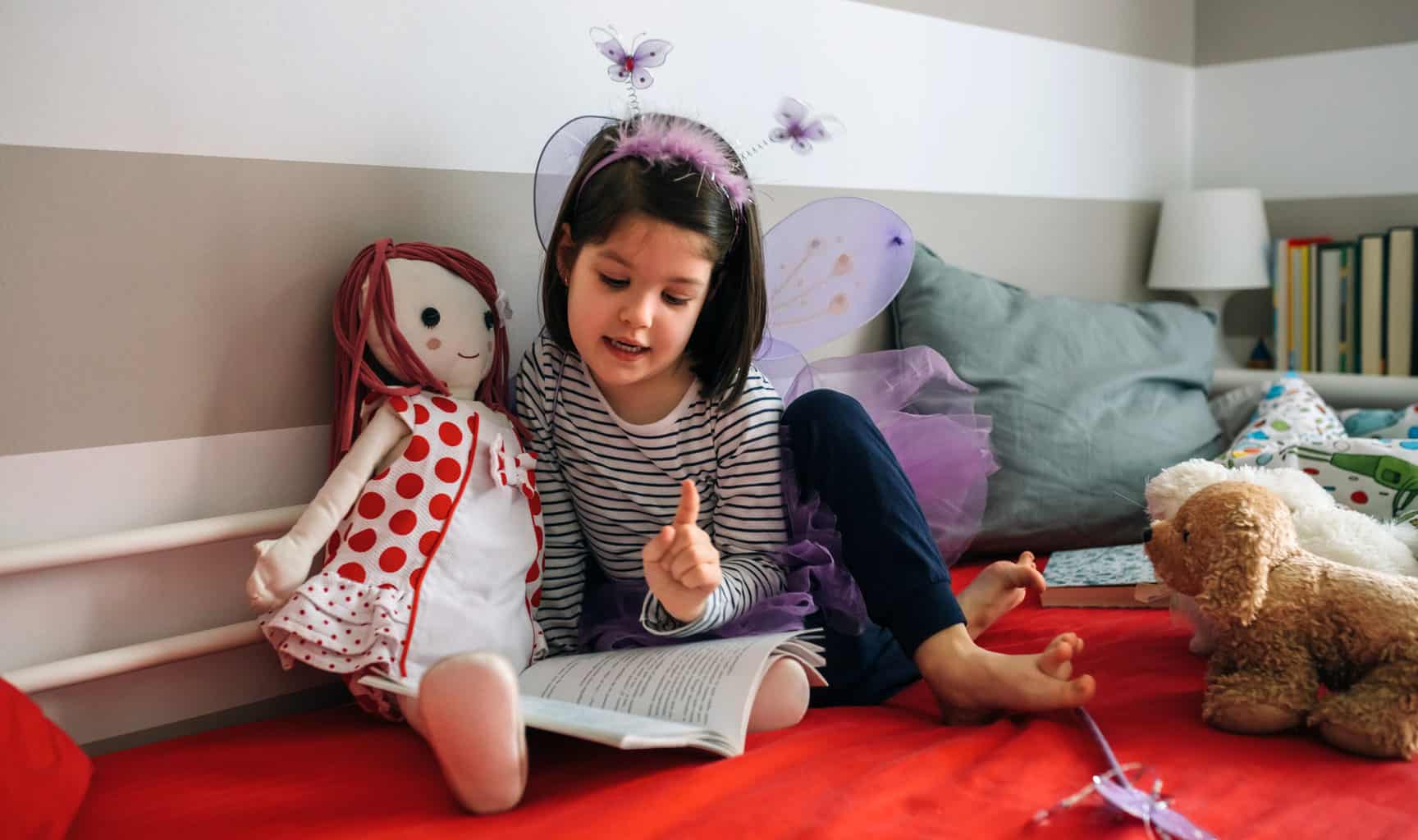Transitioning from Naptime to Quiet Time
When the time comes for your toddler to drop the last nap, it can be a challenging stage for some. I know it was for us.
Naptime battles can be frustrating and exhausting some days. Eventually, you may feel like you are the one losing the battle and decide to try switching to quiet time. Get ready for the transition with some quiet nap-time activities for non-nappers.
Some of my blog posts contain affiliate links, from which we may receive a small commission at no additional cost to you. For more info see our disclosure and privacy policy.

Ahhhh, naptime. All parents and caregivers of babies and toddlers know naptime is one of the most valuable parts of the day.
Your little one gets to rest, recharge their batteries, and grow their brain and you get a little time for yourself. Savor those blissfully quiet moments in between diaper changes and Blues Clues because all good things must come to an end. The day will come when your toddler is ready to drop the nap.
But the end of naptime doesn’t mean that your child will be just going non-stop go go go from the moment they open their eyes until they hit the sack. It also doesn’t mean have to lose your little chunk of peace and quiet during the day.
Enter quiet time.
Kids still need some downtime during the day so as not to be overstimulated and turn into little cranky bears in the evening right? Even if they are not going to nap, they still need something to do! These little non-nappers will need some calm nap-time activities during the transition and beyond.
What Is Quiet Time Anyway?
Simply put, quiet time is a scheduled portion of the day for a toddler or young child to rest their body and mind in lieu of a nap. Quiet time gives your 3,4, or 5-year-olds a chance to relax and give their senses a break by engaging in calm activities by themselves.
The sounds, sights, and stimulation of noisy electronic toys, TV, and other everyday household activities can be overwhelming.
Quiet time is a time to chill out and is so healthy for the body and mind. It can improve mood and keep them on an even keel for the rest of the day, and help create a more harmonious bedtime.
How To Set Up Quiet Time
What time of the day to do quiet time?
Young children thrive on routine so make quiet time at the same time every day. Usually, parents choose to make it the same time as their nap used to take place (give or take).
Set them up in their bedroom how you normally would for nap time. Let your child know they can sleep/rest their eyes if they’d like or simply play quietly with specific toys, activities, or stuffies.
Remember it is a transition for you both so you may be met with resistance and that’s pretty common. We always read 1 or 2 quiet storybooks before nap time so we stuck with that routine.
Setting a timer as a countdown to quiet time works for some toddlers who struggle with transitions as well. My son is 5 now and we still use timers for a lot of things, including leaving for school in the morning.
Some parents choose to play calming instrumental or zen music on low volume, or a sound machine playing soothing sounds for quiet time.
Another idea is to make a sheet or blanket fort in their room. This creates quite a cozy environment. If you have room for it, one of these teepee tents with fairy lights or a soft silicone nightlight toy would make quite the magical little hideaway! We don’t have the space for one in our house but I always found them so appealing.
If you’re into essential oils you might consider making some soothing roller bottle blends with kid-friendly oils to promote relaxation.
It’s also vital to keep household noise to a minimum so turn down the TV if your quiet time indulgence is catching up on your favorite show.
How Long Should Quiet Time Be?
Quiet time can be anywhere from 45 minutes to 2 hours in length. Personally, we found 45 wasn’t long enough and 2 hours was a bit long so we settled on an hour and a half most days.
If you do want it to last 2 hours, you may consider breaking it into chunks of time. For example, the first hour could be their alone time, playing quietly in their room, and the second could be doing a quiet activity with you or their siblings (if they have them) in another area of the home.
Now, this is where your nap time activities for non nappers come into play. Remember, the key here is to have activities that are calm so ditch the noisy talking, beeping, flashing light-type toys. No electronics!

So, what quiet, mess-free activities can children engage in during rest time?
Independent Activities for 3, 4, and 5-year-olds
(If your child is on the younger side, and still putting things in his or her mouth, stick with the activities that are safe for under 3, don’t give them toys with small parts, etc. Setting up a baby video monitor is also highly recommended to keep an eye on what they are up to).
Here are 25 great ideas of what you can do instead of naps for your toddler or preschooler:
1. Puzzles- Wooden (large piece) or magnetic puzzles with shapes, animals, numbers, or letters are fantastic for younger toddlers. Regular kids’ jigsaw or floor puzzles are perfect for bigger kids.
3. Activity Books/ Sticker Books- Endless possibilities here, connect the dots books, invisible ink pads, spot the difference or I Spy activity books.
4. Dry Erase Board and Markers- A simple dry-erase board book and some markers to draw and color with will be a hit with your budding artists.
5. A Cool Chalk Board– Add some colored chalk for a bit of fun, your child could even pretend to teach school to their dolls or stuffies.
6. Play-Do/ Modelling Clay- Little hands working these materials is great for fine motor skills and imagination! Play-Do rainbows, animals, letters, numbers, and shapes are great fun. It’s also excellent for gaining hand strength which helps pencil grip.
7. Silly Putty- A simple no-nonsense activity! I always enjoyed pressing Silly Putty on comic strips to get the imprint when I was little.
8. Duplo Blocks/Legos or Building Blocks- Some kids can just build towers for hours!
9. Dinky Cars- IF your child can play quietly with them, our son tends to like “smash ’em up derby.”
10. Wooden Train Set– See Above…Ha!
11. Pretend Purse/Wallet/Cash Register– Playing “store” is pretty popular around here. For quiet time, dolls, stuffies, or action figures could play the role of customer or shopkeeper. Pretend play like this is so important at this age!
You May Also Like: 25 Rainy Day Activities To Do With Little Kids (Indoor & Outdoor!)
12. Sorting Activities- (beads or other small objects should only be used for older kids) Sort objects by color, shape, or size. String wooden beads on pipe cleaners or ribbon by color, and make bracelets.
13. Coloring Books and Crayons- As a former server, I can assure you, there’s a reason why restaurants hand these out to kids.
14. Mr. Potato Head or Mrs. Potato Head– Another great calm activity for toddlers. Who doesn’t love these two?
15. Dollhouse and Dolls- Playing quietly with dolls is one of the best nap-time activities for non-nappers. And who knows, if they lay their baby dolls down to sleep, they may just decide to follow suit! Maybe your little one is a fan of Gabby’s Dollhouse like mine is?
16. Little People/Weebles- Oldies but goodies, these guys from Fisher-Price have been around for decades. They have stood the test of time and kids still enjoy them.
17. Drawing in a Journal- More for the 4 and 5 crowd but drawing with pencils and practicing writing in a journal is perfect for having some downtime. If they have mastered scissors, cutting out shapes, and using a glue stick in their journal could work too.
19. Connecting Math Link Cubes- This is by far our favorite obsession right now. Make patterns, shapes, whatever else you can dream up with these cool connecting cubes. I recommend these 1 million percent, especially if your preschooler is into math and numbers or likes watching the show Numberblocks. We have this Math Cubes activity set which comes with dry erase cards to work with as well. We love it!
20. Felt Books- Felt Quiet Board or felt faces with velcro (you can even DIY this one if you’re feeling crafty). If not, check out the one at the bottom of this post under Resources.
21. Toddler Flash Cards– or card decks made just for kids like Old Maid, Memory Match, or Sequencing Cards. I found this whole box set with 8 different card games and we get a lot of use out of it!
22. Busy Book or Binder- Go on Pinterest for a million ideas of how to make one or order a ready-made busy book like this one that is Montesorri style.
23. Connecting Gears- My awesome Mother-in-law scored a set of these connecting gears and they are a wonderful, colorful STEM toy for toddlers.
24. Dress-Up Trunk- Playing dress-up is always fun right? Fill a trunk or tote with different types of costumes and themed clothes. When quiet time is done, this provides a learning opportunity about tidying up after yourself and putting clothes away too (possibly…eventually).
25. Toddler-Friendly Sewing Basket- I stumbled upon this idea recently and really want to try it! Don’t worry, there are no sharp needles. Check under resources at the bottom of the page for more details on this one. Younger kids might enjoy this Wooden Apple Threading Worm Weaving Toy. Great for those fine motor skills!
Terrible Twos And Other Stages Of Kidhood
Fun & Easy STEM Activities For 3-5 Year Olds
What About Quiet Time Boxes?
Also called busy boxes, busy bins, or quiet bins; these are boxes to store specific quiet time toys or activities for toddlers or preschoolers. Not to be used for general playtime, these toys are kept in specific bins or totes and are only to be taken out at quiet time.
Quiet bins are a great way to stay organized.
Grab 4 or 5 stackable bins from the dollar store and set yourself up with any of the activities above and make several boxes. I find that the 12″X12″ plastic storage containers meant for scrapbook paper are a perfect size for quiet time boxes. I use them for a lot of our craft supplies as well.
When Do Toddlers Stop Napping?
According to experts, it varies, but usually, toddlers are ready to drop their nap around age 3 on average. Remember, that’s on average, some nap til age 4 or 5, while some are a bit earlier than 3.
When your toddler refuses to nap it may be a sign that their overall sleep needs are decreasing. If you find they are having a hard time getting to sleep at night on the days they do nap, it could be their drive to sleep is just too low at bedtime.
As long as their overall sleep is appropriate for their age (10-13 hours total), you’ll be in good shape. I know with my son, just after he turned 3 he started to fight his nap.
How the Heck To Handle the 2-Year-Old Nap Strike
Nap Time Battles Just Weren’t Worth It
For us, almost every day there was a nap time battle which left us both frustrated and unhappy. So that’s when we decided to make the switch to quiet time. In all honestly, dropping the afternoon nap wasn’t a breeze for us but your child might!
Some make the transition more easily than others, for, as we know, all kids are unique.
Well, it wasn’t a breeze for us but it wasn’t that terrible either. Just a bump in the road that toddlers and parents/caregivers navigate together. We found our way through it and so shall you.
To be honest, I found making the decision to switch took the pressure off and it was freeing because I had come to dread nap time as every day our son was more resistant or dare I say, defiant. Toddlers…who knew??
In our case, some days I just laid down in his bed with him and read until we both dozed off for 45 minutes. Those days were actually quite nice! I know, I know…some people frown on it but in my opinion, they’re only little once. No harm done and it worked out for us. Other days, he would play on his own with his Little People or Duplo Blocks or chat with his stuffies.
On the days he really did not want to stay in his room, I let him play quietly in the front room or rest on the couch. You have to pick your battles I think and for me, this wasn’t one. As long as your child is resting their body, it is helpful.
Dropping The Nap Improved My Toddler’s Nighttime Sleep
As soon as we switched from nap time to quiet time, our 3-year-old began sleeping around 12 hours a night consistently. Now that is a win in my mind.
You may find that when you drop the last nap it takes less time for your toddler to wind down at bedtime. You may also find that he or she stays asleep throughout the whole night. Of course, the odd sleep disruption will happen every now and again but that’s par for the course.
There will be days when your toddler’s nap happens and days when it doesn’t during this transitional time and that’s ok. Just do your best to stay consistent and don’t stress out too much because this too shall pass.
Travel plans, holidays, vacations, and car rides can all throw a wrench into the best-laid schedule.
For us, days that involve a long car ride could still mean a nap and our son is in kindergarten now! I can’t say as I blame him though. I love a good nap, especially on a drive. Not if I’m driving, but you knew what I meant…
Anyway, just give yourself some grace on the days when it feels frustrating. You’ve got this!
Wrapping Up
I hope some of these nap-time activities for non-nappers are helpful to you as you make the switch to quiet time. Check out the resources below for some great detailed instructions on how to make your own quiet bins, felt books, toddler sewing baskets, and more!
Until next time, K.

Kelly Blakely is the founder and creative force behind Just Our View From Here. As a first-time mom over 40, she brings a fresh perspective to parenting and family life on her blog. Kelly also explores a wide range of lifestyle topics in her writing, including fashion, beauty, self-care, and well-being.
Benefits Of Taking Your Kids To The Library
11 Compelling Reasons to Bring Your Kids to the Library A Library is a magical…
The Best Educational Toddler Shows on Netflix
Streaming Smarts: Unleash the Power of Netflix for Your Little Learners! Hello, super moms and…
Easy Fall Arts And Crafts Ideas For Kids
Simple Autumn Arts And Crafts For September & October It’s fall y’all! It’s the perfect…
Positive Parenting Top Tips For Parents
How To Be A Better Parent ( Without Yelling) As a mom myself, I know…
Reading With Preschoolers-Tips For Parents
Are You Wondering How To Raise A Reader? When it comes to kids and reading,…
Space Books For Toddlers And Preschoolers To Blast Off Learning!
30 Preschool Books About Space And Astronomy Updated Feb. 9, 2023 Toddlers and preschoolers who…
Nap Time Activities for Non-Nappers Resources
Quiet Time Bin Ideas by Mama Megan Allysa
DIY Quiet (Felt) Book by Powerful Mothering
Felt Faces Craft by Smiling Colors
DIY Busy Binder by Teaching Littles
Toddler-Friendly Sewing Basket by Childhood 101
You may also like:
Just Our View From Here is a participant in the Amazon Services LLC Associates Program, an affiliate advertising program designed to provide a means for sites to earn advertising fees by advertising and linking to Amazon.com.









